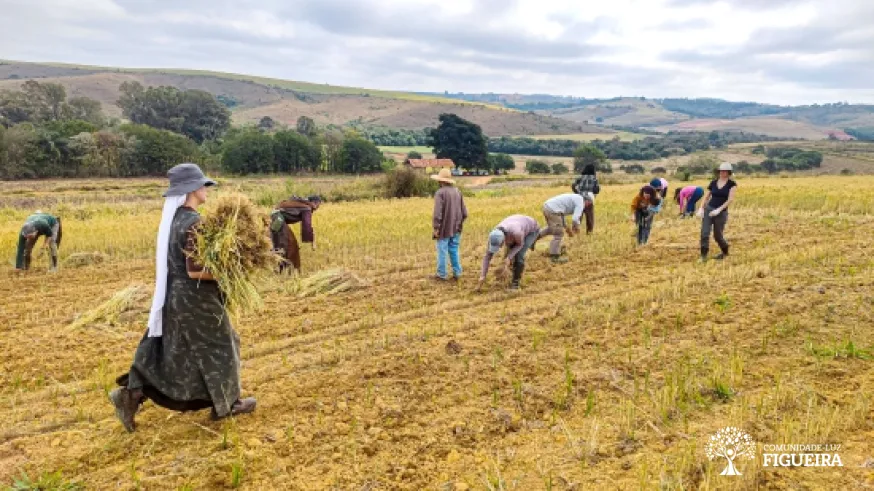Category: Sustainable Agriculture
Specialists say that, in order to obtain healthy food, it is not enough to plant organically. The cultivated soil must be alive, with its natural mechanisms working in balance. Thus, the vegetables that arrive at our table will be full of that life that is renewed every day by Mother Nature.
In the Light-Community Figueira, affiliated to the Fraternidade - Humanitarian Federation (FFHI), care for the land is the basis of horticulture that is implemented in four places inside the Community: in F2, in Terras do Sol, in Terras da Irmandade and Nucleo Corazon Sagrado.
In each of these areas, the soil has its own characteristics and the same principle of vitalization through sustainable management techniques that aim to improve the quality of the land (often exhausted by old practices of monoculture and the use of agrochemicals). For example, the simple and efficient technique of green manuring (cover croping), which is made from specific seeds that nourish and aerate the soil. How does this work in practice?
The help of seeds: action in the preparation of the base for planting and maintenance of gardens
Twice a year — in autumn and spring — the Planting and Seed Sector puts this method of green manuring into action, which consists of sowing seeds that, when germinating, will produce plants that fix nitrogen, are rich in proteins and produce a green mass to cover the ground.
These types of seeds, in addition to revitalizing the land, become very ornamental and protective plants for existing species.
How to make it?
Choose a single type of seed or mix them in a “friendship cocktail”. Throw them into the ground at random, covering them with a light layer of earth, or sow them in furrows (narrow and long furrows) that are parallel and ordered, between which vegetables are planted.
At the end of the vegetative cycle, the Planting Sector harvests the seeds for the next season, while the mother plants are left in the ground as an excellent cover to maintain moisture and nutrients.
For spring: jack beans, crotalaria, pigeon peas, millet, or buckwheat (attracts pollinating insects), etc. For autumn: the pivoting fodder radish, vetch, black oats, ryegrass, etc.
ATTENTION:
Improper for human and animal consumption: jack bean and sunn hemp.
Suitable for animal consumption: vetch, ryegrass, black oats, turnip, millet.
Suitable for human consumption: pigeon pea, buckwheat (buckwheat), millet.
Planting time
With the earth taken care of, it is time to plant the vegetables through direct planting or by transplanting seedlings that were sown in trays or other containers. In order to prolong production cycles, the Planting and Seed Sector often uses both systems simultaneously.
For example: beets, turnips and radishes are sown directly into the ground and also transplanted from the containers they were started in — in seedbeds. Thus, explains Frei Renatto, coordinator of the sector, an offer is obtained of these foods better distributed throughout the year. While the seedling is transformed into the desired food, the seeds of the same plant begin their cycle from an earlier stage and, later on, they will also reach their apex as already formed fruits of the earth.
Intercropping and crop rotation
Another management technique widely used in community gardens is the consortium between plants, because the companionship between plants is like between people where unity is strength.
“Within the wisdom of Nature, there are species of plants with ample functions, be it stimulating mutual development, protection or direct action in the life of the soil”, explains Frei Renatto. Thus, the principle of consortium between plants is applied in the daily life of the Planting and Seed Sector which, through observation, studies and records this relationship in order to learn a little more about their interactions.
And as a fundamental complement to the practice of intercropping, the community gardens are constantly undergoing the procedure of crop rotation so that the land is permanently regenerated and restored, including through spontaneous plants. “This practice helps the plants to be maintained vigorously through the natural renewal, that the plants themselves bring to the beds and to the places where they are planted in an orderly and organized way”, adds Frei Renatto.
God’s irrigation, man’s irrigation and agroforestry practices
These gardens and the food they produce are especially nourished by the water that falls from the sky (rain), a gift from God, and by the irrigation made with pure water from the springs maintained by the community. The constant care for these water holes and their recharge areas (hill tops) is attributed to agroforestry practices carried out in all planting and reforestation areas. With meticulous care, it is observed which trees are most suitable to protect the soil and surroundings of the springs, as well as their planting time, stratification, size, longevity, usefulness and well-being within the systems in which they were introduced. These tree species also contribute to maintaining air and soil moisture, avoiding excessive and often unnecessary expenses with mechanical irrigation.
We can say that the earth/seeds/plants/water/human beings contact results in a harvest of food that nourishes not only the body, but the soul of all who live in the community and those who come to collaborate.
Food donation: Sharing nature's goods
So that a greater number of people have access to the gifts that the Community of Light receives through these planting systems and their fresh food, every week the morning harvest that takes place in the gardens of F2 and Terras do Sol is shared with the families in need in nearby Carmo da Cachoeira, a small town in the south of Minas Gerais where all areas of the Light-Community of Figueira are located.
JOIN US
LIVE NATURE AND FRATERNITY!


